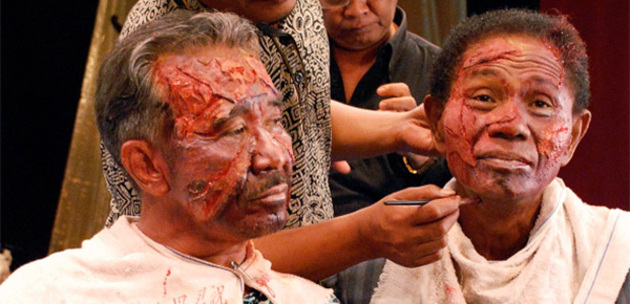THE ACT OF KILLING
Drafthouse Films
Reviewed for Shockya by Harvey Karten. Data-based on RottenTomatoes.com
Grade: A-
Director: Joshua Oppenheimer
Screenwriter: Joshua Oppenheimer
Cast: Anwar Congo, Herman Koto, the people of Medan, Indonesia
Screened at: Park Ave., NYC, 6/25/13
Opens: July 19, 2013
One of the sophomoric questions that teachers ask, well, of students in their second year of media studies, is: “Do movies create violence?” There is no conclusive answer to this, which makes the query one that evokes a plethora of classroom discussions. Let’s turn the question on its head: “Does violence create movies?” Yes, of course, pictures of war and crime in the real world do motivate the production of films to mirror this, but in the case of Joshua Oppenheimer’s “The Act of Killing,” we have what just might be an original in documentary history. Oppenheimer, a Harvard-educated Londoner who speaks the local language, traveled to Indonesia’s North Sumatra province to create a doc that might make some audience members run up and tear down the screen. That’s how blood-boiling the feature can be. He takes an actual series of events 1965-66 after the coup that deposed Sukarno in favor of Suharto, specifically the massacre of up to one million of the archipelago’s communists. Though the Communist Party of Indonesia may have been the world’s largest such organization outside of the Soviet Union and China, it’s clear that the majority of people killed by paramilitary forces with the encouragement of the U.S. government were not communists, and most of those who really were revolutionaries had no hand in plotting the overthrow of the Suharto government.
As for how violence creates movies, get this: Oppenheimer interviewed and gained not only the trust but the encouragement of two people who by any stretch of the Geneva Convention were war criminals, asking them to re-enact their crimes from forty-eight years ago. The perps, Anwar Congo and Herman Koto, both freelance killers, were personally responsible for the one-by-one killing of at least a hundred people suspected of being communists. No trial, no exploration of the victims’ intentions to plot the government’s overthrow, and in addition the killers went after the ethnic Chinese minority. Congo and Koto had a special motive. The communists led a boycott of popular American movies. The duo made their living as ticket scalpers. Because of the successful boycott, they lost much of their prospective income. Lovers of Hollywood gangster fare in particular, Congo and Koto responded to Oppenheimer’s radical suggestion that they re-enact their crimes, even demonstrating how they killed their victims by their preferred method of strangling them with wires—a technique they picked up from Hollywood pics.
The two former killers are an odd duo: Congo is slim and dignified in appearance while Koto is morbidly obese and vulgar. The latter got into hamming Hollywood style by dressing in drag, eager to see how the British filmmaker would picture them as stars. The “stars” gathered the local people to play victims. Older women were directed to scream and beg for mercy and urge the vigilantes not to burn down their homes. Some of the children, who put on realistic impressions of the tragedy, continued crying after the takes were shot. Like a Fourth of July fireworks that save the best for the final minutes, the climax of the movie is the burning down of a so-called communist village over the pleas of men, women and children. It’s doubtful that more than a few individuals at the time even heard of Karl Marx or knew of the existence of communism in the Soviet Union and China (if they heard of those countries at all).
Interrogation scenes were staged, the perps torturing their victims to get names of other “communists,” while one in particular brags that he’s all for raping pretty women, particularly the “delicious” ones age fourteen. Remember, that the most horrifying aspect of their movie roles is that they bear no remorse for their activities but consider themselves heroes—as do elements of the Indonesia government. It doesn’t help the cause of morality that they appeared on nationwide TV, a smiling hostess encouraging their bloody confessions. “We don’t need the Geneva Convention. Replace it with the Jakarta Convention,” states one.
Despite the originality of the proceedings, the film is marred by its length, its repetitions, and a long bookend showing pretty young women dancing by a restaurant in the shape of a fish. Documentarians Errol Morris and Werner Herzog were so impressed that they signed on as executive producers, the latter calling this the scariest movie he’s seen in a decade or more. Watch, if you can, for the one literally nauseating scene at the conclusion, one in which one of the perps finally questions the morality of what he did. It’s too bad that in 1965 he was not asked—as he was here—to portray himself as a victim about to be executed. He might have felt enough revulsion to bow out of his violent game. Of course, the film is scheduled to make an appearance at the 2013 Human Right Festival.
Unrated. 122 minutes © 2013 by Harvey Karten, Member, New York Film Critics Online
Story – A-
Acting – B
Technical – B+
Overall – B+

